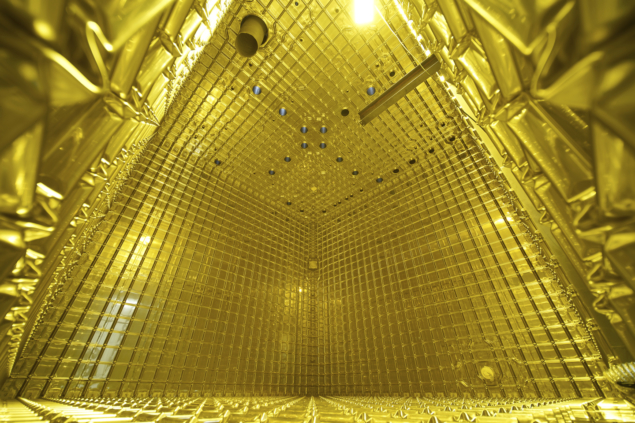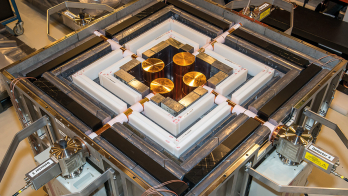
The Deep Underground Neutrino Experiment (DUNE) in the US is set to replicate that marvel of model-making, the ship-in-a-bottle, on an impressive scale. More than 3000 tonnes of steel and other components for DUNE’s four giant detector modules, or cryostats, must be lowered 1.5 km through narrow shafts beneath the Sanford Lab in South Dakota, before being assembled into four 66 × 19 × 18 m3 containers. And the maritime theme is more than a metaphor: to realise DUNE’s massive cryostats, each of which will keep 17.5 kt of liquid argon (LAr) at a temperature of –200°, CERN is working closely with the liquefied natural gas (LNG) shipping industry.
Since it was established in 2013, CERN’s Neutrino Platform has enabled significant European participation in long-baseline neutrino experiments in the US and Japan. For DUNE, which will beam neutrinos 1300 km through the Earth’s crust from Fermilab to Sanford, CERN has built and operated two large-scale prototypes for DUNE’s LAr time-projection chambers (TPCs). All aspects of the detectors have been validated. The “ProtoDUNE” detectors’ cryostats will now pave the way for the Neutrino Platform team to design and engineer cryostats that are 20 times bigger. CERN had already committed to build the first of these giant modules. In June, following approval from the CERN Council, the organisation also agreed to provide a second.
Scaling up
Weighing more than 70,000 tonnes, DUNE will be the largest ever deployment of LAr technology, which serves as both target and tracker for neutrino interactions, and was proposed by Carlo Rubbia in 1977. The first large-scale LAr TPC – ICARUS, which was refurbished at CERN and shipped to Fermilab’s short-baseline neutrino facility in 2017 – is a mere twentieth of the size of a single DUNE module.
Scaling LAr technology to industrial levels presents several challenges, explains Marzio Nessi, who leads CERN’s Neutrino Platform. Typical cryostats are carved from big chunks of welded steel, which does not lend itself to a modular design. Insulation is another challenge. In smaller setups, a vacuum installation comprising two stiff walls would be used. But at the scale of DUNE, the cryostats will deform by tens of cm when cooled from room temperature, potentially imperilling the integrity of instrumentation, and leading CERN to use an active foam with an ingenious membrane design.
The nice idea from the liquefied-natural-gas industry is to have an internal membrane which can deform like a spring
Marzio Nessi
“The nice idea from the LNG industry is that they have found a way to have an internal membrane, which can deform like a spring, as a function of the thermal conditions. It’s a really beautiful thing,” says Nessi. “We are collaborating with French LNG firm GTT because there is a reciprocal interest for them to optimise the process. They never went to LAr temperatures like these, so we are both learning from each other and have built a fruitful ongoing collaboration.”
Having passed all internal reviews at CERN and in the US, the first cryostat is now ready for procurement. Several different industries across CERN’s member states and beyond are involved, with delivery and installation at Sanford Lab expected to start in 2024. The cryostat is only one aspect of the ProtoDUNE project: instrumentation, readout, high-voltage supply and many other aspects of detector design have been optimised through more than five years of R&D. Two technologies were trialled at the Neutrino Platform: single- and dual-phase LAr TPCs. The single-phase design has been selected as the design for the first full-size DUNE module. The Neutrino Platform team is now qualifying a hybrid single/dual-phase version based on a vertical drift, which may prove to be simpler, more cost effective and easier-to-install.
Step change
In parallel with efforts towards the US neutrino programme, CERN has developed the BabyMIND magnetic spectrometer, which sandwiches magnetised iron and scintillator to detect relatively low-energy muon neutrinos, and participates in the T2K experiment, which sends neutrinos 295 km from Japan’s J-PARC accelerator facility to the Super-Kamiokande detector. CERN will contribute to the upgrade of T2K’s near detector, and a proposal has been made for a new water Cherenkov test-beam experiment at CERN, to later be placed about 1 km from the neutrino beam source of the Hyper Kamiokande experiment . Excavation of underground caverns for Hyper Kamiokande and DUNE has already begun.
DUNE and Hyper-Kamiokande, along with short-baseline experiments and major non-accelerator detectors such as JUNO in China, will enable high-precision neutrino-oscillation measurements to tackle questions such as leptonic CP violation, the neutrino mass hierarchy, and hints of additional “sterile” neutrinos, as well as a slew of questions in multi-messenger astronomy. Entering operation towards the end of the decade, Hyper-Kamiokande and DUNE will mark a step-change in the scale of neutrino experiments, demanding a global approach.
“The Neutrino Platform has become one of the key projects at CERN after the LHC,” says Nessi. “The whole thing is a wonderful example – even a prototype – for the global participation and international collaboration that will be essential as the field strives to build ever more ambitious projects like a future collider.”








